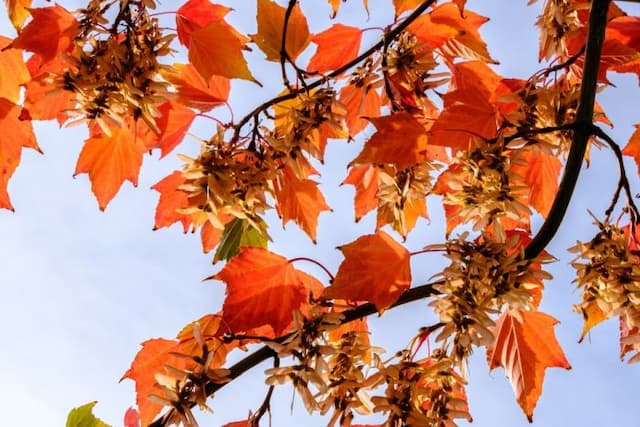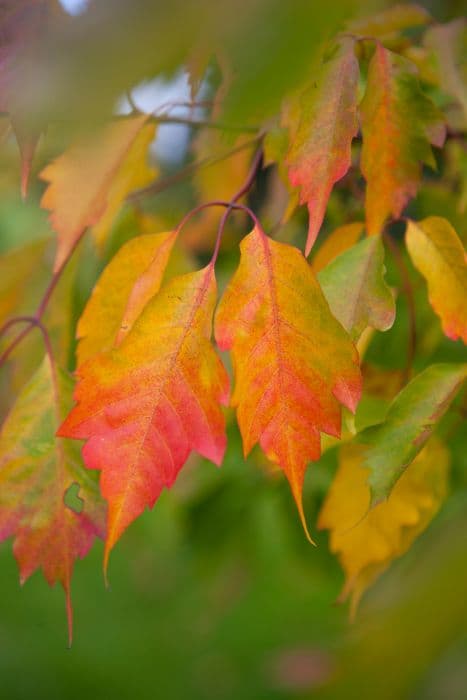Japanese Maple Acer palmatum 'Ornatum' (D)

ABOUT
The Japanese maple known as 'Ornatum' is a visually striking plant, appreciated for its aesthetic qualities. It features an intricate structure with branches that spread out to create a graceful, rounded shape. Leaves are the star of the show, with their deeply cut and finely pointed lobes that give them a delicate, feathery appearance. The foliage exhibits a rich, purple hue that can add a splash of dramatic color to any garden space. As seasons change, so do the leaves, transitioning through a range of colors from their initial springtime reddish-purple to a vibrant crimson in the fall, providing year-round interest. The bark on 'Ornatum' is smooth, lending a subtle texture to the plant's overall look. The smaller, ornate leaves contrast beautifully against the bark, creating a play of color and form that can enhance many landscaping designs. The plant produces inconspicuous flowers followed by winged seeds that are typical of Japanese maples, but it is predominantly grown for its stunning leaf color and attractive shape. With its elegant and sophisticated appearance, 'Ornatum' is a cherished addition to gardens, offering a touch of refined beauty and a sense of serene, natural artistry.
About this plant
 Names
NamesFamily
Sapindaceae
Synonyms
Japanese Maple, Threadleaf Japanese Maple, Cutleaf Japanese Maple, Laceleaf Japanese Maple, Dissectum Maple
Common names
Acer palmatum var. ornatum (Dippel) H.Hara.
 Toxicity
ToxicityTo humans
Japanese Maple is generally regarded as safe and non-toxic to humans. There are no widespread reports of poisoning or adverse effects from ingesting parts of this plant. Therefore, accidental consumption should not typically cause concern or result in poisoning symptoms.
To pets
Japanese Maple is not considered toxic to pets. It does not have a reputation for being harmful if pets should chew or ingest its leaves or seeds. Therefore, pet owners usually do not need to worry about poisoning symptoms from this plant.
 Characteristics
CharacteristicsLife cycle
Perennials
Foliage type
Deciduous
Color of leaves
Mixed
Height
6-8 feet (1.8-2.4 meters)
Spread
6-8 feet (1.8-2.4 meters)
Plant type
Tree
Hardiness zones
5-8
Native area
Japan Korea China
Benefits
 General Benefits
General Benefits- Aesthetic Appeal: The Japanese Maple 'Ornatum' adds visual interest with its delicate, deeply lobed leaves that provide a unique texture to the landscape.
- Seasonal Color: It offers vibrant fall colors that range from crimson to gold, enhancing the seasonal beauty of gardens and outdoor spaces.
- Shade Providing: The broad canopy of the Japanese Maple can offer a cool, shaded area, which is beneficial in creating comfortable outdoor spaces during warmer months.
- Wildlife Habitat: The tree can serve as a habitat and offer food for birds and other wildlife, promoting biodiversity in garden settings.
- Size Suitability: Its moderate size makes it suitable for small gardens or spaces where large trees might be impractical.
- Low Maintenance: The Japanese Maple 'Ornatum' is relatively low maintenance compared to other ornamental trees, requiring minimal pruning and care once established.
- Versatility: It can be used in various landscape designs, from traditional Japanese gardens to contemporary urban settings, showing great adaptability.
- Property Value: Landscaping with aesthetically pleasing trees like the Japanese Maple can increase property values and curb appeal.
 Medical Properties
Medical PropertiesThis plant is not used for medical purposes.
 Air-purifying Qualities
Air-purifying QualitiesThis plant is not specifically known for air purifying qualities.
 Other Uses
Other Uses- Photography backdrops: Photographers often use Japanese Maple trees like Acer palmatum 'Ornatum' for their beautiful and intricate foliage as a stunning natural backdrop in portrait and landscape photography.
- Bonsai: The species is commonly used for bonsai due to its small leaves, attractive color, and the ability to take well to pruning and training.
- Artistic inspiration: Artists may utilize Japanese Maple as an inspiration for various art forms, including painting, sculpture, and even textile design.
- Cultural symbolism: In Japanese culture, the Acer palmatum 'Ornatum' is often associated with peace and serenity, and can be used in gardens to create a tranquil environment.
- Wedding decor: Branches of Japanese Maple can be used in floral arrangements or as part of venue decorations for their unique leaf shapes and colors.
- Culinary presentation: Leaves of the Japanese Maple can be used as a creative presentation element for high-end culinary dishes, although they are not edible.
- Feng Shui applications: Some people believe that placing a Japanese Maple in certain areas of the garden can help to balance the flow of energy, according to Feng Shui principles.
- Educational tool: Japanese Maple trees can serve as an educational tool for botany and horticulture students to learn about plant morphology and taxonomy.
- Cinema and theatre: The striking appearance of the Japanese Maple can be used to set the scene or convey a particular mood in films and stage productions.
- Urban landscaping: Due to their size and ornamental value, Japanese Maples are ideal for urban landscaping where space may be limited and aesthetic appeal is important.
Interesting Facts
 Feng Shui
Feng ShuiThe Japanese Maple is not used in Feng Shui practice.
 Zodiac Sign Compitability
Zodiac Sign CompitabilityThe Japanese Maple is not used in astrology practice.
 Plant Symbolism
Plant Symbolism- Beauty and Elegance: The fine lace-like foliage and delicate form of the Japanese Maple symbolize beauty and elegance, adding an aesthetic appeal to any space.
- Peace and Tranquility: Often found in traditional Japanese gardens, the Japanese Maple is associated with peace and tranquility, evoking a sense of calm and serenity.
- Balance and Harmony: With the balanced structure of its symmetrical leaves and branches, the Japanese Maple represents balance and harmony in nature.
- Endurance and Change: The species' ability to adapt to different climates and its changing leaf colors throughout the seasons symbolize endurance and change over time.
- Unique Individuality: Given the diversity of leaf types and colors within the species, each tree is unique, symbolizing individuality and the importance of celebrating differences.
 Water
WaterJapanese Maples, including the 'Ornatum' variety, prefer consistent moisture but do not like to be waterlogged. It is optimal to water them once a week with about 10 gallons of water, although you may need to adjust the frequency depending on the weather and soil drainage. During hot or windy conditions, they may require more frequent watering, twice a week may be necessary. In contrast, reduce watering during the winter dormant period. It's important to check the soil moisture at a depth of a few inches to ensure it is moist but not saturated before watering again.
 Light
LightJapanese Maples thrive in partial shade, with some protection from harsh afternoon sun, which can scorch their delicate leaves. The 'Ornatum' variety will do well in a location that benefits from morning sunlight and dappled afternoon shade. Avoiding deep shade is also crucial, as it can lead to leggy growth and poor leaf color.
 Temperature
TemperatureJapanese Maples enjoy moderate temperatures and are hardy in a range from 14°F to 140°F, but their ideal growing conditions fall between 60°F and 80°F. They are not suited for extreme cold or heat; prolonged exposure beyond their hardiness range can lead to stress or damage. It's important to plant them in an area that experiences seasonal temperature changes within their tolerance range.
 Pruning
PruningPruning Japanese Maples is mainly done to enhance their natural form, remove any dead or damaged branches, and encourage a strong structure. The 'Ornatum' should be pruned in late winter or early spring, before new growth begins. It's important to prune sparingly and to focus on maintaining the tree's graceful, natural shape rather than imposing a style upon it.
 Cleaning
CleaningAs needed
 Soil
SoilJapanese Maple thrives in well-draining, consistently moist soil with a pH ranging from slightly acidic to neutral. A mix of loamy soil with peat moss and perlite is ideal to retain adequate moisture while avoiding waterlogging. Mulching helps to maintain soil moisture and temperature.
 Repotting
RepottingJapanese Maples in containers should be repotted every 2-3 years. Choose a slightly larger pot to allow for growth, and repot in the spring before new leaves emerge.
 Humidity & Misting
Humidity & MistingJapanese Maple prefers average humidity levels. It does not require high humidity and can tolerate the humidity levels typically found in temperate climates.
 Suitable locations
Suitable locationsIndoor
Bright, indirect light with cool, well-ventilated air.
Outdoor
Partial sun, protected from strong winds, and well-drained soil.
Hardiness zone
5-8 USDA
 Life cycle
Life cycleAcer palmatum 'Ornatum', commonly known as Japanese Maple 'Ornatum', begins its life cycle as a seed, which germinates in favorable conditions of moisture and temperature. Upon germination, a seedling emerges, establishing roots and a shoot that will develop into the tree's characteristic finely dissected purplish-red leaves. The sapling stage follows, during which the tree experiences rapid growth and begins to develop its classic, elegant branching structure. As the tree matures, it enters a long productive phase where it fully develops its canopy, produces flowers, and subsequently winged seeds called samaras, which are dispersed by wind. In the autumn, the tree's foliage undergoes a dramatic color change to vibrant reds and oranges before leaf drop. The Japanese Maple 'Orumnatum' has a lifespan that can exceed several decades if grown in optimal conditions and with proper care.
 Propogation
PropogationPropogation time
Early spring
Propogation: The Japanese Maple 'Ornatum', like many of its kind, is usually propagated through grafting, which is most successful when undertaken in late winter before the sap begins to flow. This popular method involves taking a scion or cutting, typically 4 to 6 inches (10 to 15 centimeters) long, from a healthy 'Ornatum' tree. The scion is then grafted onto a rootstock, commonly the Acer palmatum species, which has a compatible diameter; the two are joined using a technique such as side veneer or whip and tongue grafting. The graft union is wrapped with grafting tape or a similar material, and the grafted plant is kept in high humidity and at a temperature of around 70 degrees Fahrenheit (21 degrees Celsius) until the union heals and the graft is established. This process can take several weeks, after which the plant can be gradually acclimated to outdoor conditions.









